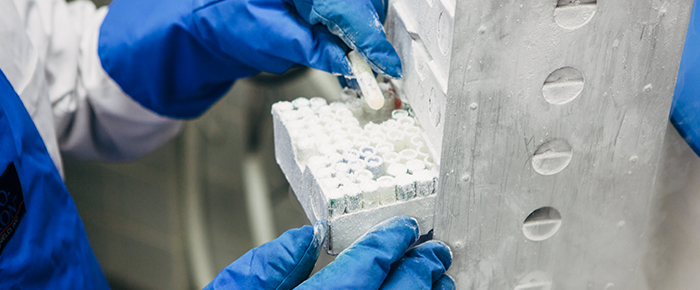
Room Temperature (+20°C/+68°F)
Certain reagents and biological samples can be kept at room temperature, even for long-term storage. This primarily includes tissues that have been preserved in alcohol, formalin, or another fixative solution. These samples can be used for histology or anatomical analysis, but DNA and RNA extracted from these samples would be highly degraded and as such not usable. Any type of molecular biology analysis requires freezer storage.
Refrigerated Storage (4°C/40°F)
In laboratories, refrigerators are used to store routinely used biological reagents and buffers. This can include certain antibodies and enzymes, buffers for regularly performed experiments, as well as cell culture media. Freshly collected blood samples or tissue biopsies can also be stored in refrigerators for short periods, but should not be used for any long-term storage. Many research facilities also have cold rooms, that act as large refrigerators, allowing experiments and incubations to be done at 4°C far more easily.
Optimal for short-term storage, refrigerators are great for storing reagents that will quickly lose integrity with repeated freeze-thaw cycles, as long as they are used within a manufacturer’s recommended time frame. They can also be used to temporarily store tissues or even DNA/RNA while you wait for a piece of lab equipment to become available.
Freezer Storage (-20°C/-4°F)
Standard freezers are great for storing biochemical reagents and samples that are not stable at warmer temperatures. Found in most labs in the form of refrigerator/freezer combos, they are perfect for a lab with limited space. These freezers are typically used for more short-term freezer storage of samples that are routinely used, or needed for an upcoming experiment. This includes aliquots of peptides, antibodies, DNA, and RNA used for daily reactions, as well as tissues that have been suspended in the appropriate stabilizing solutions before freezing. However, more long-term storage will require an ultra-low temperature freezer.
Ultra-Low Temperature Freezer Storage (-80°C/-112°F)
Ultra-low temperature freezers are the optimal choice for long-term storage of biological material and will prevent the degradation of proteins, nucleic acids, and larger molecules. As they are intended for long-term storage, freeze-thaw cycles are to be avoided, as this could still lead to degradation of protein and DNA. Material that will be used routinely should be aliquoted and stored in standard freezers.
The increasing need to store an ever-growing number of samples has led research institutes to establish freezer farms, entire rooms dedicated solely to freezer storage. These freezers will typically be connected to an alarm system, to notify lab personnel in case of a failure, and some are even equipped with a liquid nitrogen tank backup, to maintain their temperature in case of a power outage.
The need to retrieve samples stored in ultra-low temperature freezers quickly and efficiently has also led to the use of freezer storage accessories and software to speed up the process. Laboratory information management software (LIMS) can be used to accurately manage your inventory of samples, including noting their exact location, down to the rack, box, column, and row. Moreover, tools like the CryoHolder can be used to quickly pick-up and move cryo vials. In addition, ultra-low temperature freezers are used to slowly freeze cells, prior to storing them in liquid nitrogen. This is accomplished by using a commercially available container (Mr. Frosty) filled with alcohol, that helps achieve an optimal freezing rate of about 1°C per minute.
Liquid Nitrogen Storage (-196°C/-321°F)
Liquid nitrogen storage is considered the gold standard for long-term cryogenic storage of biological samples. Liquid nitrogen is also used to snap freeze samples, as it is a great way to suspend activity and prevent degradation of sensitive samples and specimens. For extended storage, like ultra-low temperature freezers, freeze-thaw cycles are also a concern and can lead to sample degradation.
Most commonly used to store cells in liquid nitrogen Dewars, used for cell culture. These tanks are great for storing a large number of vials necessary per cell line (primary, immortalized, stem cell) which require multiple aliquots to be frozen and at various passages. Liquid nitrogen storage is also widely used by the assisted reproductive technology (ART) field to store sperm, oocytes, and embryos.
The choice of storage temperature for your biological materials is critical to ensuring the integrity of your samples. However, in parallel to the storage condition, you should also consider the identification method used, as this will also vary with storage temperature. Labels designed for room temperature and refrigerator storage will not hold-up during cryogenic storage, while cryogenic labels are not required for simple benchtop labeling needs.
LabTAG by GA International is a leading manufacturer of high-performance specialty labels and a supplier of identification solutions used in research and medical labs as well as healthcare institutions.